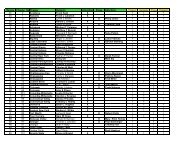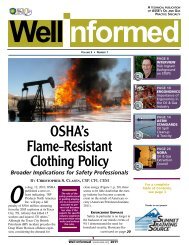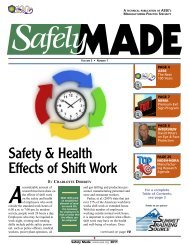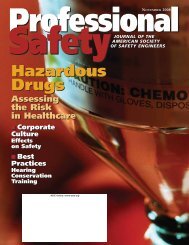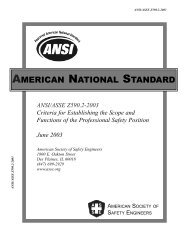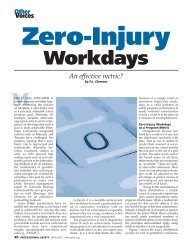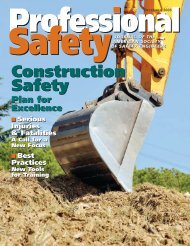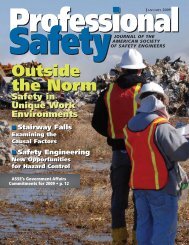Safety 2008 - ASSE - American Society of Safety Engineers
Safety 2008 - ASSE - American Society of Safety Engineers
Safety 2008 - ASSE - American Society of Safety Engineers
You also want an ePaper? Increase the reach of your titles
YUMPU automatically turns print PDFs into web optimized ePapers that Google loves.
In theLoopElectrical <strong>Safety</strong>Foundation Internationalwarns thatthe potential forhazardous electricalconditions is increasingas <strong>American</strong>s puta greater burden onthe electrical systemsin older homes.Only54% <strong>of</strong>surveyedbusinessesplan toprovidesafetytraining tostudentworkers,AccidentFundsurveyfinds.Older Homes at GreaterRisk <strong>of</strong> Electrical FireHome electrical problems account for nearly55,000 fires every year, causing more than 500deaths, more than 1,400 injuries and $1.4 billion inproperty damage. Older homes are ateven greater risk <strong>of</strong> fire. According to areport from the Fire Protection ResearchFoundation (FPRF), serious dangers canexist and <strong>of</strong>ten remain hidden in electricalsystems <strong>of</strong> older homes.Electrical <strong>Safety</strong> Foundation International(ESFI) warns that the potential forhazardous electrical conditions is increasingas <strong>American</strong>s put a greater burden onthe electrical systems in older homes.Homes built before 1973—which accountfor half <strong>of</strong> the homes in the U.S. accordingto census data—predated many <strong>of</strong>the appliances and electronics that arecommon today, including more than athird <strong>of</strong> homes built before hair dryers orelectric can openers were invented.“As each year goes by <strong>American</strong>s are using moreenergy in their homes,” says Brett Brenner, ESFIpresident. “Many homes and electrical systems inthe U.S. are simply being overburdened, leading t<strong>of</strong>ires, deaths and injuries.” ESFI encourages homeownersto have their homes’ electrical systems thoroughlyinspected by qualified electricians, ensuringthat all electrical work in the home meets the safetyprovisions <strong>of</strong> the National Electrical Code.ESFI is providing consumers with a checklist thatwill allow them to identify electrical dangers commonlyfound in each room <strong>of</strong> their home. ESFI willalso be educating owners <strong>of</strong> older homes on newerfire prevention technology such as arc fault circuitinterrupters, which can detect dangerous conditionsand cut <strong>of</strong>f power to the circuit before a fire develops.For information on electrical safety in olderhomes, visit www.electrical-safety.org. To downloadthe complete FPRF report, visit www.homewiringsafety.com.Accident Fund Program Aims toReduce Teen Workplace InjuriesNIOSH estimates that about 70 teenagers die eachyear from work-related injuries, and nearly70,000 are injured severely enough to be taken to theemergency room. Yet, according to Accident Fund’srecently completed Future Business Index, only 54%<strong>of</strong> businesses surveyed plan to provide any safetytraining to student workers, despite saying thatworkplace safety is a high priority.“We were surprised to hear that so few companies<strong>of</strong>fer safety training to student employees,”says Accident Fund’s Keith Adkins. “Parents mightbelieve their children are receiving adequate safetytraining, but based on the survey results, that isn’tnecessarily the case.”In an effort to decrease teen workplace injuries,Accident Fund developed WorkSafe Students, a6 PROFESSIONAL SAFETY AUGUST <strong>2008</strong> www.asse.orgfree workplace safety program for use in highschools and businesses. The program, a 45-minuteinteractive awareness session geared toward highschool juniors and seniors, addresses child laborlaws and potential workplace hazards. It includes ateaching guide; a student booklet, “Nightmare onEmployment Street: Accident Fund’s Teen Guide toWorkplace <strong>Safety</strong>,” which uses a horror-movietheme; and a short video, Lost Youth: Four Stories <strong>of</strong>Injured Young Workers.For more information about the program, visitwww.worksafestudents.com.Kennedy Report Criticizes OSHAEarlier this year, Senator Edward Kennedy, Chair<strong>of</strong> the Health, Education, Labor and PensionsCommittee, released a report that is critical <strong>of</strong>OSHA’s penalty system and enforcement. It containsseveral key conclusions:•OSHA’s penalties system for safety violationsresulting in fatalities is flawed.•OSHA rarely refers even flagrant fatality cases tothe Department <strong>of</strong> Justice for criminal investigation.•OSHA does not effectively use its enforcementprogram to monitor even the worst employers afterfatalities.“The report’s findings demonstrate serious flawsin our health and safety laws and OSHA’s enforcement<strong>of</strong> them,” says Kennedy. “Congress needs toclose the gaps in the law, strengthen its provisionsand insist on strong enforcement by OSHA.”To download the complete report, visit www.philaposh.org/pdf/<strong>2008</strong>KennedyReport.pdf.USPS Campaign Warns Childrento “Stay Away From the Truck”U.S. Postal Service (USPS) has launched a publicservice campaign to warn children to stay awayfrom postal delivery vehicles. Franklin, an animatedversion <strong>of</strong> the postal service eagle, and his birdfriend Benny are featured in a public serviceannouncement(PSA) that aims tohelp prevent injuriesand deaths that canoccur when childrenget too close todelivery vehicles.“We hope thiscampaign will raise awareness that children shouldnever approach our vehicles that are making deliveries,”says USPS’s Deborah Giannoni-Jackson.“This message is especially timely during the summerwhen children are not in school and more likelyto be playing outside.” The 30-second PSA is part<strong>of</strong> a broader child awareness safety program fromUSPS, the National Association <strong>of</strong> Letter Carriers andthe National Rural Letter Carriers’ Association. Thecampaign targets prekindergarten through secondgradechildren, and includes a longer animated videoand other materials to use in a school setting. Learnmore at www.usps.com.



